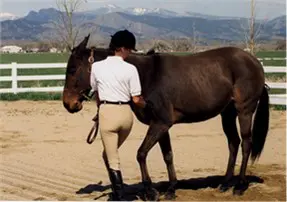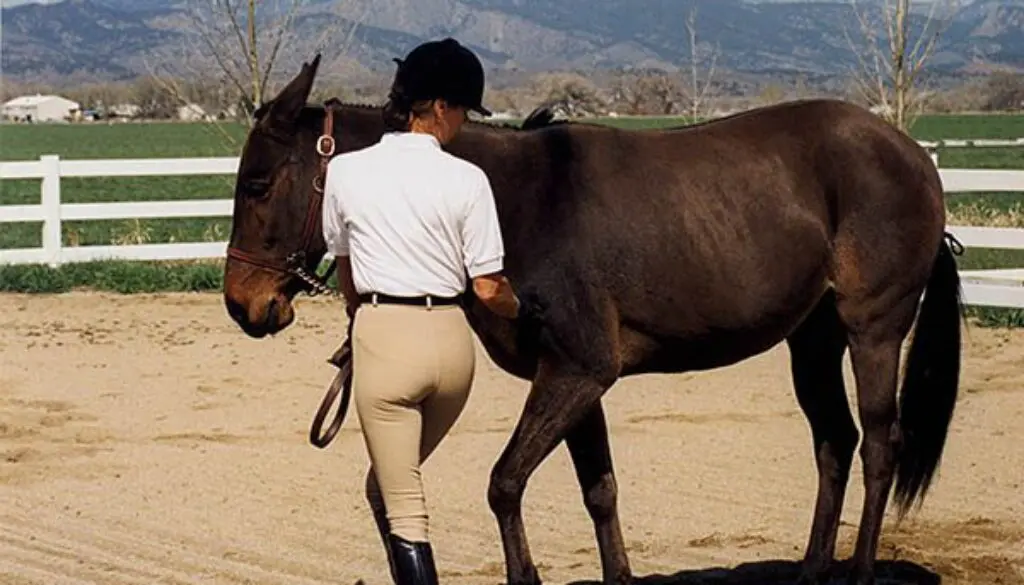MULE CROSSING: Showing Equines
 By Meredith Hodges
By Meredith Hodges
Many years ago mules and donkeys were numerous in America. Their strength and endurance made them ideal pack and work animals. Their contributions to the building of this great nation were unmatched, yet in 1966 their numbers had declined to the point of near extinction. With the coming of the Industrial Revolution, their services were no longer in demand. In 1987, the American Donkey & Mule Society celebrated its 20th Anniversary. The society was formed by Paul and Betsy Hutchins of Denton, Texas in 1967 in response to a need to appreciate the work of these fine, Longeared animals and to find new uses for them. Over the past 40 years, appreciation for these wonderful animals has gained momentum and with each new experiment, we find that these Longears are capable of a wide variety of uses in today’s world.
 They are limited only by the imagination of The gift we have found with Longears is one that needs to be shared with others so that they might also experience the joy and pleasure these animals have to offer. In this hustle-and-bustle world, it is easy to take for granted the importance of love, sharing and simple pleasures derived from personal growth. Mule and donkey shows are a vehicle we can use to bring these things to light and revitalize the appreciation of Longears. The show ring is a place where mules and donkeys can exhibit the results of experiments with their owners and trainers, in exceptional horsemanship and performance, where challenges are met with both humor and enthusiasm. They can be pets, performers, pleasure mounts, or just plain hard workers.
They are limited only by the imagination of The gift we have found with Longears is one that needs to be shared with others so that they might also experience the joy and pleasure these animals have to offer. In this hustle-and-bustle world, it is easy to take for granted the importance of love, sharing and simple pleasures derived from personal growth. Mule and donkey shows are a vehicle we can use to bring these things to light and revitalize the appreciation of Longears. The show ring is a place where mules and donkeys can exhibit the results of experiments with their owners and trainers, in exceptional horsemanship and performance, where challenges are met with both humor and enthusiasm. They can be pets, performers, pleasure mounts, or just plain hard workers.
However, many people are intimidated by the show ring for many reasons: a lack of show-quality animals and training time, a lack of available transportation, inopportune geographical locations and the fear of equine politics. We must remember that this intimidation was born of the horse show formats and the involvement of large amounts of money. There are literally millions of horses in this equine industry that are being shown all over the world. Out of necessity, the shows are divided and specialized according to ability and breeding.
This is the only fair way to progress and accommodate the growing numbers of horses and horse owners. In the midst of this overwhelming competitive spirit, we sometimes lose sight of the true benefits of showing. Showing can be an opportunity to test your equestrian skills and to share new ideas and concepts with others. It should be fun as well as enlightening.
 Because showing mules and donkeys is relatively new, there is much to be gained by participation. Those who feel that their animal is not of show quality can still attend shows and learn a lot about Showmanship, grooming and training skills. This development of new skills can make the difference between show quality or not, particularly in performance events. Newcomers to showing also give the audience something extra-special. The enthusiasm of the newcomer is often very contagious and the audience always finds Longears shows incredibly entertaining. They feel that this is something that they too could manage to do and enjoy. Those who feel they just cannot put in enough training time can still participate in a lot of the plain old fun classes that the show rosters include. There are enough mule and donkey clubs today that sponsor all kinds of shows and all one needs to do is contact any one of them to acquire the information that you need.
Because showing mules and donkeys is relatively new, there is much to be gained by participation. Those who feel that their animal is not of show quality can still attend shows and learn a lot about Showmanship, grooming and training skills. This development of new skills can make the difference between show quality or not, particularly in performance events. Newcomers to showing also give the audience something extra-special. The enthusiasm of the newcomer is often very contagious and the audience always finds Longears shows incredibly entertaining. They feel that this is something that they too could manage to do and enjoy. Those who feel they just cannot put in enough training time can still participate in a lot of the plain old fun classes that the show rosters include. There are enough mule and donkey clubs today that sponsor all kinds of shows and all one needs to do is contact any one of them to acquire the information that you need.
Probably the most intimidating fear of all is the fear of making some awful mistake in the show ring…in front of “God” and EVERYONE! I doubt that there is anyone showing who hasn’t experienced that awful mistake at least once in the course of learning. It’s all part of the process! “To err is human…” and err we do! I remember riding my mule in a Green Western Pleasure Class several years ago. When they asked us to trot in and line up, my mule tripped and fell flat on his face! Was my face red! Another time in a Trail Class at the World Mule Show, I picked up a plastic bag full of tin cans that rattled loudly and scared the tar out of my mule. He took off, lickety-split, out of the Trail Class and down the racetrack in front of more than 20,000 spectators! If I could have died at that moment, I would have, but I DID survive and the embarrassment of the moment subsided. The disaster of yesterday has become the source of a humorous story to tell others for years to come! So, let’s not allow too much seriousness and false pride to spoil an otherwise REALLY good time with friends! Learn from your mistakes, but don’t let them cripple you.
Time and money can be a hindrance to showing today. Economic issues are quite prevalent today, but as they say…”Where there’s a will, there’s a way!” With careful planning and the conscientious setting of priorities, one can determine the number of shows one can easily attend in a season. Those who sponsor and work on shows are sensitive to the needs of the exhibitors and are willing to help in every way they possibly can. Most donkey and mule shows are not all that expensive and can be managed quite easily.
At most of the larger one-day shows, those who wish to do so are allowed to tie to their trailers to save on stall fees. This is true in a lot of regions. Entering fewer classes will also save money and still provide you with the important learning and social benefits of showing. There are so many different sizes, colors and abilities in mules and donkeys today. Show committees encourage as many participants as possible in order to have the Longears breeds adequately represented. Schooling Horse Shows welcome the novelty of the Longears animals!
 Geographical locations and transportation can also restrict showing opportunities. With a little help and a lot of ingenuity, these issues can be resolved. One just needs to decide which shows would benefit them the most and then plan accordingly. If the show is some distance away, families, or groups, can pool their efforts and cut expenses dramatically. The growth of the mule and donkey industry has increased the number of shows throughout the country. They are now more numerous in remote areas and easy to reach. If you live in a really remote area, you might want to start a Longears Group and host your own schooling shows, or you can always request permission to ride in the Open Classes at Horse Shows in your area. Either way, you are doing important work in the promotion of Longears!
Geographical locations and transportation can also restrict showing opportunities. With a little help and a lot of ingenuity, these issues can be resolved. One just needs to decide which shows would benefit them the most and then plan accordingly. If the show is some distance away, families, or groups, can pool their efforts and cut expenses dramatically. The growth of the mule and donkey industry has increased the number of shows throughout the country. They are now more numerous in remote areas and easy to reach. If you live in a really remote area, you might want to start a Longears Group and host your own schooling shows, or you can always request permission to ride in the Open Classes at Horse Shows in your area. Either way, you are doing important work in the promotion of Longears!
Last, but certainly not least, a word about politics. In the mules and donkey industry, we are not campaigning, not competing ruthlessly against horses and ponies. We are simply promoting our beloved mules and donkeys and their incredibly versatile abilities and looking to improve our own Mulemanship ability. As individual riders and owners meet their challenges and succeed, we should all feel warmth and joy for their accomplishments. Those individuals and their Longears have worked long and hard. They stand as representatives and heroes for us all. We can all learn to be proud and supportive of the greater cause.
When in competition, compete against yourself and learn to derive joy and pleasure from your own improvements and the improvement of others. There is a lot that showing has to offer besides ribbons and trophies. Showing gives you the opportunity to test your skills and measure your success. It helps to assess different skills and make personal choices, expand your social interaction and share knowledge gained with those that have similar interests. Most of all, showing gives each of us the opportunity to exhibit good sportsmanship and do our part in support of our beloved Longears!
To learn more about Meredith Hodges and her comprehensive all-breed equine training program, visit LuckyThreeRanch.com or call 1-800-816-7566. Check out her children’s website at JasperTheMule.com. Also, find Meredith on Facebook, YouTube, Pinterest, Instagram, MeWe and Twitter.
Covered in TRAINING MULES & DONKEY: A LOGICAL APPROACH TO TRAINING, TRAINING WITHOUT RESISTANCE and EQUUS REVISITED at www.luckythreeranchstore.com
© 1987, 2016, 2024 Lucky Three Ranch, Inc. All Rights Reserved.




